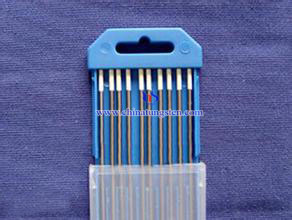Zirconium Tungsten Electrode Manufacturing
- Details
- Category: Tungsten Information
- Published on Tuesday, 26 July 2016 17:56

The most important feature of zirconium tungsten electrode is under high load current the tip can still maintain spherical, reducing the tungstenizing phenomenon. And it is commonly used for aluminum and its alloys welding, magnesium and its alloys welding and coated oxide film copper welding. Doped with small amount of zirconia (ZrO2) on the basis of tungsten substrate and produced by powder metallurgy after processing can obtain zirconium tungsten electrode. ZrO2 uniformly dispersed in the grain boundaries and grains can hinder grain growth, grain boundary slipping and dislocation climbing, which play a good strengthening effect on electrode, therefore zirconium tungsten electrode has good high temperature performance, stable arcing, low arc voltage, ablation resistance and non-radioactive and other good properties. Compared to lanthanum tungsten electrode, thorium tungsten electrode and other tungsten electrode material it has stronger advantages. Comparing zirconium tungsten electrode (WZ8) with lanthanum tungsten electrode (WL10) found, WZ8 used for AC welding the electrical property is similar with WL10, but the burning rate is less than WL10.
Manufacturing processes:
1. The zirconium oxychloride (ZrOCl2 • 8H2O) was dissolved in deionized water and added WO3 with constant stirring.
2. The mixed solution after dehydrated, dried and 2 times reduction can obtain WZ8 powder. The Fsss particle size is about 2.5 ~ 3.5um.
3. Using 500T hydraulic machine pressed WZ8 powder into 13mmx13mmx520mm square strip and the weight is about 940g.
4. Then after pre-sintered and incipient fusion to obtain zirconium tungsten alloy billet and the density is about 17.0 ~ 18.0g / cm3.
5. After swaging, stretching and other subsequent processing can obtain a diameter of 1.0mm zirconium tungsten electrode.
During the production, ZrO2 phase transformation will lead to shrinkage and expansion, so around the ZrO2 particle is easily to form voids or cracks, affecting the processing performance of the electrode. Further, the electrode density is not uniform, if the cogging temperature is low, then it will produce cracks on electrode, causing subsequent processing difficulties.
| Tungsten Metals Supplier: Chinatungsten Online www.tungsten.com.cn | Tel.: 86 592 5129696; Fax: 86 592 5129797;Email:sales@chinatungsten.com |
| Tungsten News & Prices, 3G Version: http://3g.chinatungsten.com | Molybdenum News & Molybdenum Price: http://news.molybdenum.com.cn |



 sales@chinatungsten.com
sales@chinatungsten.com